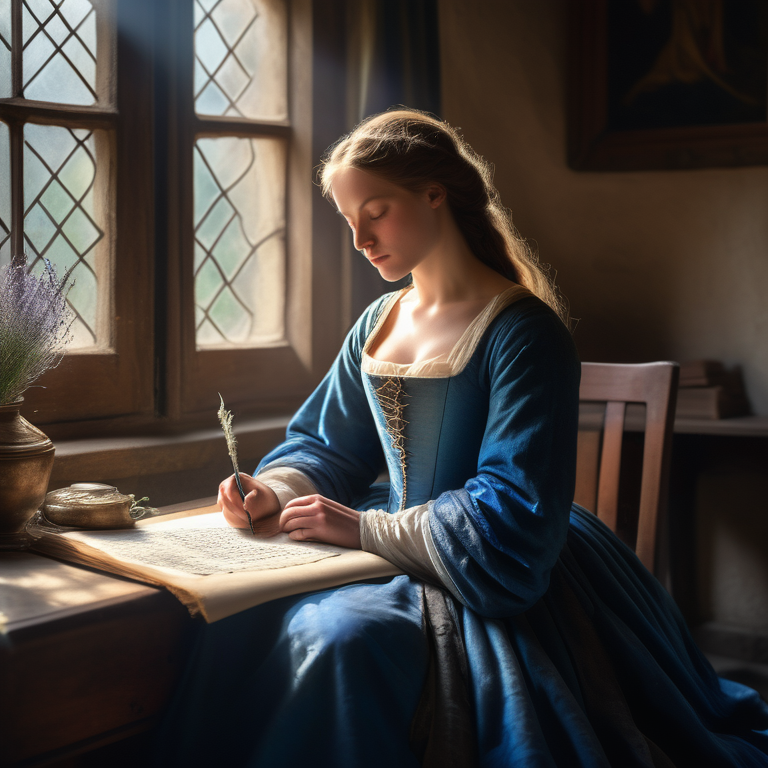Medieval Perspectives on Female Sexuality

Key Highlights
- Medieval society had complex and contradictory views on female sexuality
- The concept of virginity and chastity played a significant role in social and religious contexts
- Chastity belts were not as prevalent in medieval culture as popularly believed
- Marriage in medieval times was often influenced by power dynamics and women had limited autonomy
- The legal and social stance on rape during the medieval period was different from today
- Medical understandings of female sexuality were based on the humoral theory and included various treatments
- Religious and legal regulations shaped sexual morality in medieval Europe
- There is evidence of female homosexuality in medieval records, but societal reactions varied
- FAQs cover the policing of women’s sexualities, advocates for women’s sexual rights, portrayal of female sexuality in medieval literature, and insights from medieval medical and religious texts
Introduction
Medieval Europe, spanning from the 5th to the 15th century, was a time of immense cultural, social, and religious change. It was a period characterized by the dominance of the Catholic Church, feudalism, and the rise of city-states. In this blog, we will explore the different perspectives on female sexuality during this time, including the beliefs of secular jurisdiction and Canon Law in the European Middle Ages.
The Concept of Virginity and Chastity in Medieval Times
In medieval society, the concept of virginity and chastity held great importance. Virginity was seen as a state of purity and innocence, especially for women. Chastity, on the other hand, was the virtue of abstaining from sexual activity outside of marriage and using contraception. Both concepts were heavily influenced by the teachings of the Church Fathers and shaped the expectations and behaviors of medieval women.
The Role of Virginity in Social and Religious Contexts
Virginity was highly valued in medieval society, particularly for women. It held a symbolic representation of purity and virtue. Women who remained virgins were seen as morally superior and were often venerated as saints. The Church Fathers emphasized the importance of virginity in religious texts and sermons, encouraging celibacy for both men and women. In some cases, women who took a vow of virginity became nuns or dedicated their lives to religious service. Virginity also played a significant role in the social status of women, particularly young girls. A woman’s virginity was often seen as a valuable commodity, and marriages were arranged to maintain family honor and ensure the purity of the bloodline. The loss of virginity before marriage was considered a grave sin and could lead to social ostracism and even legal consequences.
Chastity Belts: Myth vs. Reality
Chastity belts are often associated with the medieval period, but their prevalence and purpose have been exaggerated in popular culture. While there are accounts of chastity belts being used, they were not as widespread as commonly believed. Here are some key points to consider:
- Chastity belts were more likely to be used as a form of punishment or control rather than as a means of preventing sexual activity
- They were typically made of metal and designed to prevent access to the genitals
- Some chastity belts were used by men to control their wives or female partners, but this was not a common practice
- The idea of chastity belts as a way to ensure female fidelity is largely a myth perpetuated by later interpretations of medieval culture
- The use of chastity belts in the medieval period was influenced by a variety of factors, including social norms, gender roles, and power dynamics
Marriage, Consent, and Power Dynamics
In medieval times, marriage was often influenced by power dynamics and women had limited autonomy in choosing their partners. Consent, as we understand it today, was not always a factor in marital unions. Here we explore the dynamics of marriage during this period and the legal stance on consent.
Marital Expectations and Women’s Autonomy
Marriage in medieval society was primarily seen as a contractual arrangement between families and often had little to do with love or personal choice. Women, specifically young women, were expected to fulfill certain roles and duties within the marriage, including bearing children and managing the household. Their autonomy and agency were limited, as they were often subject to the authority of their husbands and families. While some women were able to negotiate certain aspects of their marriages and exercise influence behind the scenes, the overall power dynamics within the institution of marriage were heavily skewed in favor of men, specifically young men. It was not uncommon for marriages to be arranged for political or economic reasons, and women had little say in the matter.
The Legal and Social Stance on Rape
The legal and social stance on rape during the medieval period was vastly different from today. Consent was not a central concern, and the focus was often on property rights and honor rather than the well-being of the victim. Here are some key points to consider:
- Rape was often seen as a crime against the property or honor of the victim’s family rather than a violation of the victim’s body and autonomy
- Punishments for rape varied depending on the social status of the victim and the perceived impact on the honor of the family
- In some cases, the victim of rape could be blamed and stigmatized, while the perpetrator might face minimal consequences
- The legal system was often biased in favor of men, making it difficult for women to seek justice for sexual violence
Medical Understandings of Female Sexuality
In medieval times, medical understandings of female sexuality were based on the humoral theory, which held that the body was governed by four humors – blood, phlegm, yellow bile, and black bile. Medical treatments for various sexual issues were based on balancing these humors. However, there were also some medical perceptions that recognized and valued women’s sexual pleasure. For example, medieval Christian writers believed that in order to conceive a child, a woman had to achieve orgasm. This belief came from the Galenic model of reproduction, which held that conception occurred due to the union of male and female “seed,” both of which were emitted in response to sexual pleasure. Here we explore the medical perspectives on female sexuality during this time, including the recognition of sexual pleasure.
Humoral Theory and Its Impact on Women’s Health
According to the humoral theory, women’s health and sexuality were believed to be influenced by the balance of the four humors. Medical treatments for various sexual issues aimed to restore this balance. Here are some key points to consider:
- Women were believed to have a different balance of humors compared to men, which influenced their physical and emotional well-being
- Medical treatments for sexual problems often involved purging or balancing the humors through diet, herbal remedies, and bloodletting
- The humoral theory also influenced ideas about women’s temperament and behavior, with certain imbalances being associated with excessive lust or frigidity
- Medical practitioners in the medieval period were often monks or clergy members, and their understanding of women’s health and sexuality was influenced by religious beliefs and societal norms
Medical Treatments and Misconceptions
Medical treatments for sexual issues in the medieval period were based on the available knowledge and understanding of the time. However, many of these treatments were based on misconceptions and superstitions. Here are some key points to consider:
- Medical treatments often focused on restoring the balance of humors or addressing perceived imbalances in women’s bodies
- Remedies could include herbal concoctions, bloodletting, and dietary changes
- Some treatments may have provided temporary relief or a placebo effect, but they were not always based on scientific evidence or a true understanding of the underlying causes of sexual issues
- Misconceptions and superstitions surrounding women’s bodies and sexuality contributed to the limited effectiveness of medical treatments during this time
Religious and Legal Regulations
Religious and legal regulations played a significant role in shaping sexual morality during the medieval period. Here we explore the influence of religious teachings and canon law on sexual practices and behaviors.
Canon Law: Defining Sexual Morality
Canon law, the body of laws and regulations established by the Catholic Church, played a central role in defining sexual morality during the medieval period. Here are some key points to consider:
- Canon law outlined the Church’s position on various sexual issues, including marriage, adultery, and homosexuality
- The teachings of the Church Fathers and religious authorities shaped the interpretation and application of canon law
- Sexual acts outside of marriage were considered sinful and morally wrong, and penalties could be imposed for violations of the Church’s teachings
- The enforcement of canon law varied in different regions of medieval Europe, and local customs and traditions also influenced the understanding and implementation of sexual morality
Punishments and Penances for Sexual ‘Sins’
The medieval church prescribed various punishments and penances for sexual “sins” in an attempt to enforce sexual morality. Here are some key points to consider:
- Penances could range from simple acts of contrition to more severe punishments such as public humiliation or physical penances
- The severity of the punishment often depended on factors such as the social status of the individuals involved and the perceived impact on the reputation of the church or the community
- Penances were meant to serve as a form of spiritual purification and reconciliation with God, rather than as retribution or deterrence
- The enforcement of penances and punishments varied depending on the local bishop or religious authorities, and there could be significant disparities in how sexual sins were treated
Expressions of Female Homosexuality
The expression of female homosexuality in the medieval period was shaped by societal attitudes and religious teachings. Here we explore the documentation and societal reactions to lesbian relationships during this time.
Documentation and Historical Evidence
Documentation of female homosexuality in the medieval period is limited, but there are historical records and texts that provide some insight into the existence of lesbian relationships. Here are some key points to consider:
- Historical evidence of lesbian relationships often comes from court records, personal correspondences, or literary texts
- These records provide glimpses into the experiences and relationships of women who were attracted to other women
- It is important to approach these sources with caution and consider the social and cultural context in which they were written
- The attitudes towards lesbian relationships varied depending on the time period, geographical location, and the influence of religious and societal norms
Societal Reactions to Lesbian Relationships
Societal reactions to lesbian relationships in the medieval period were influenced by a combination of religious, social, and cultural factors. Here are some key points to consider:
- The attitudes towards lesbian relationships varied depending on the region and the influence of religious teachings
- In some cases, lesbian relationships were condemned and seen as sinful or deviant behavior
- The church’s stance on homosexuality played a significant role in shaping societal attitudes, with teachings condemning same-sex relationships as immoral
- However, there were also instances where lesbian relationships were tolerated or even celebrated, particularly in certain artistic and literary circles
Conclusion
In conclusion, exploring medieval perspectives on female sexuality provides valuable insights into the social, religious, and medical frameworks of that period. The concepts of virginity, chastity, marriage dynamics, and medical beliefs all shaped the understanding and regulation of female sexuality. By delving into historical narratives and societal norms, we can better appreciate the evolution of attitudes towards women’s sexual autonomy. Understanding these perspectives sheds light on the complexities and challenges faced by women in medieval times, highlighting the importance of advocating for gender equality and rights. Share this knowledge on social media to continue the conversation on this intriguing aspect of history.
Frequently Asked Questions
How were women’s sexualities policed during the medieval period?
During the medieval period, women’s sexualities were policed through a combination of religious teachings, legal regulations, and societal norms. The church played a significant role in shaping sexual morality, while legal authorities enforced laws related to sexual conduct. Social norms and expectations also placed constraints on women’s behavior and sexuality.
Were there any known advocates for women’s sexual rights in the Middle Ages?
While women’s sexual rights were not a prominent focus in the Middle Ages, there were individuals who advocated for women’s rights and challenged traditional gender norms. One notable figure is Christine de Pizan, a medieval writer and philosopher who championed the rights and intellectual capabilities of women. Her works contributed to the early development of gender studies.
How did medieval literature portray female sexuality?
Medieval literature often portrayed female sexuality in complex and nuanced ways. One notable example is the character of the Wife of Bath in Chaucer’s “The Canterbury Tales,” who openly embraces her sexuality and speaks candidly about her desires. This portrayal challenges traditional expectations of female modesty and highlights the diversity of female experiences.
Did medieval medical or religious texts offer any insights into female sexuality?
Both medical and religious texts from the medieval period provide some insights into female sexuality. Medical texts often discussed female reproductive health and treatments for various sexual issues based on the humoral theory. Religious texts offered moral guidance and teachings on sexual conduct. Here is a text table summarizing the information:
|
Type of Text |
Insights into Female Sexuality |
|
Medical texts |
– Discussion of reproductive health and treatments for sexual issues |
|
Religious texts |
– Moral guidance on sexual conduct |
|
Both types of texts |
– Influence of societal norms and misconceptions on understanding female sexuality |





